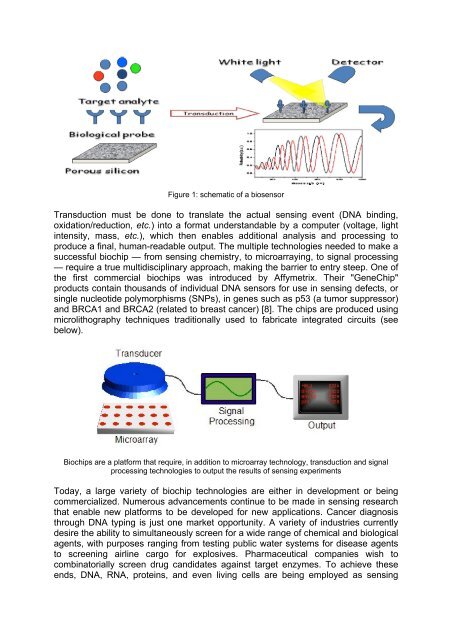PDF (tesi dottorato ROTIROTI) - FedOA - Università degli Studi di ...
PDF (tesi dottorato ROTIROTI) - FedOA - Università degli Studi di ...
PDF (tesi dottorato ROTIROTI) - FedOA - Università degli Studi di ...
Create successful ePaper yourself
Turn your PDF publications into a flip-book with our unique Google optimized e-Paper software.
Figure 1: schematic of a biosensor<br />
Transduction must be done to translate the actual sensing event (DNA bin<strong>di</strong>ng,<br />
oxidation/reduction, etc.) into a format understandable by a computer (voltage, light<br />
intensity, mass, etc.), which then enables ad<strong>di</strong>tional analysis and processing to<br />
produce a final, human-readable output. The multiple technologies needed to make a<br />
successful biochip — from sensing chemistry, to microarraying, to signal processing<br />
— require a true multi<strong>di</strong>sciplinary approach, making the barrier to entry steep. One of<br />
the first commercial biochips was introduced by Affymetrix. Their "GeneChip"<br />
products contain thousands of in<strong>di</strong>vidual DNA sensors for use in sensing defects, or<br />
single nucleotide polymorphisms (SNPs), in genes such as p53 (a tumor suppressor)<br />
and BRCA1 and BRCA2 (related to breast cancer) [8]. The chips are produced using<br />
microlithography techniques tra<strong>di</strong>tionally used to fabricate integrated circuits (see<br />
below).<br />
Biochips are a platform that require, in ad<strong>di</strong>tion to microarray technology, transduction and signal<br />
processing technologies to output the results of sensing experiments<br />
Today, a large variety of biochip technologies are either in development or being<br />
commercialized. Numerous advancements continue to be made in sensing research<br />
that enable new platforms to be developed for new applications. Cancer <strong>di</strong>agnosis<br />
through DNA typing is just one market opportunity. A variety of industries currently<br />
desire the ability to simultaneously screen for a wide range of chemical and biological<br />
agents, with purposes ranging from testing public water systems for <strong>di</strong>sease agents<br />
to screening airline cargo for explosives. Pharmaceutical companies wish to<br />
combinatorially screen drug can<strong>di</strong>dates against target enzymes. To achieve these<br />
ends, DNA, RNA, proteins, and even living cells are being employed as sensing

















